2019.01.23
Visiting the Real Japan in Shimane Prefecture By Anthony Meadow
We came to Japan in December (Christmas in Tokyo!) but wanted to experience something of the real Japan. During our last visit to Japan with our kids, we spent almost all of our time in Tokyo and Kyoto. We enjoyed this trip very much, but this time we were up for more of an adventure.
We looked at the list of UNESCO World Heritage Sites in Japan when I noticed that there were sites added since our last trip 15 years ago. The new sites preserved industrial areas which were instrumental in Japan’s transition to becoming one of the world’s largest economies. I decided we would to go to Kyushu (where we could see some of the sites that are part of the “Sites of Japan’s Meiji Industrial Revolution: Iron and Steel, Shipbuilding and Coal Mining”), Shimane (“Iwami Ginzan Silver Mine and its Cultural Landscape”) and Tokyo (“Tomioka Silk Mill and Related Sites”). We would also go to museums, temples and shrines, and walks in older towns, but we would visit them in areas that are not as well known in America.
We learned some Japanese so that we could find our way around and order in restaurants. It turned out to be very useful when we were in Kyushu and Shimane because relatively few people speak or read English. We used every word we learned!
Shimane Prefecture
In researching Shimane prefecture, our second destination of this trip, I found that it is one of the least-visited prefectures. True, it takes all day to get there, even partially via a Shinkansen (and then via an express train from Okayama to Matsue over the mountains), but nevertheless it sounded quite intriguing. Every prefecture and most towns seem to have their own website for visitors from Japan and overseas.
Going through a few sites focused on Shimane such as <https://www.kankou-shimane.com/en/> and <https://sanin-japan.com> turned up many interesting things to see and do. We could easily have spent a couple of weeks in Shimane, but we only had three full days. A practical consideration was figuring out how to get around using trains, taxis, and walking since we were not renting a car. It took some time to figure out the logistics, but we narrowed down the possibilities until we had a full but realistic schedule for all three days.
For lodging we booked a western style room at the Tamatsukuri Grand Hotel Choseikaku <https://www.choseikaku.co.jp/eng/>. Choseikaku is located in Tamatsukuri Onsen, a town about 10 minutes from downtown Matsue via train. As the town name implies, Tamatsukuri Onsen has many hot springs (onsen). The town has been known for onsens for a long time – over a thousand years.
Choseikaku was a wonderful place to stay: the staff was very warm and helpful, and their onsens are very nice indeed. Both the men’s and women’s onsen have outdoor pools with beautiful rocks and waterfalls. One of our great pleasures was to sit in the outdoor pools at night, with a gentle rain falling while soaking in the hot water. We also enjoyed a delicious kaiseki meal (traditional multi-course Japanese dinner) in their restaurant. Our room was more spacious than we expected.
Day one – Omori and the Iwami Ginzan Silver Mine
Our first full day in Shimane was a visit to the Iwami Ginzan silver mine, a UNESCO World Heritage site. Websites for the Iwami Ginzan Silver Mine World Heritage Center and Omori town <https://ginzan.city.ohda.lg.jp/1750.html>, turned up all the details we needed, including walking directions in English <https://www.ginzan-wm.jp/>. After a little more searching around I discovered a website for a volunteer group that offered tours in English <https://www.all-iwami.com/en/sekitou/#ginzan>. I arranged for an English-speaking guide to walk us through the mining areas.
When we arrived in Omori, we first explored the Kigami Shinto shrine.Next up was the Iwami-Ginzan Museum in the former magistrate’s office.
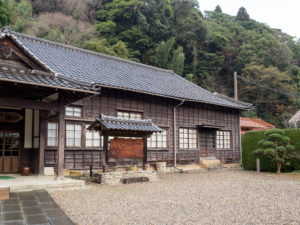
The former magistrate’s office which now houses the Iwami Ginzan Memorial Museum in Omori (大森).
There are some excellent displays on the history of the mines, mining tools and techniques, and some superb models of the mines and workers. There were scrolls illustrating the mining process in detail, as well as maps. It’s a very good introduction to the town and the mining sites.
We walked through the town, with many charming houses, and a cat that would not take no for answer! Next was the former Kumagai Residence, home to an important and wealthy family which was very involved in the silver mines. By this time I had become used to seeing relatively small homes in Japan, but this house is huge, with more than 30 rooms. There are displays of mining-related materials, clothing, dishes (and the kitchen) and many other items.

One of the rooms in the Former Kumagai Residence (熊谷家住宅).
We met our guide at the Heritage Center and she took us on a walking tour from the town all the way up to the Ryugenji Mabu mine shaft, explaining what we saw along the way. We saw the remains of the Shimizudani processing mill, many Buddhist temples and Shinto shrines. The initial silver deposit was discovered in 1526. The mines were finally closed in the 1920s. Although it was an overcast December day with a little rain thrown in, we learned a lot about the history and what it was like to live there. (Miners always lead difficult lives.) It was also a delight to meet someone who lived in the area who could tell us about life in Japan now.
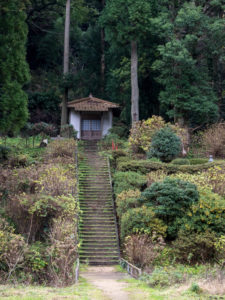
Myoshoji (妙正寺) Buddhist temple on the road between Omori town and the Iwami Ginzan mining shafts. When the mines were very productive there were one hundred temples in the area.
We returned to Tamatsukuri Onsen, dropped off our backpacks at the hotel and went looking for dinner. We found an informal soba/udon shop in the neighborhood called Sobatomi (そば富) <https://tabelog.com/en/shimane/A3201/A320101/32000609/> and had some delicious hot soup after a long cold day.
Day two – Izumo and Matsue
On our second full day in Shimane, we went to Izumo and Matsue. We took the JR train from Tamatsukurionsen station to Izumoshi. Our first stop was to visit the Shimane Museum of Ancient Izumo (古代出雲歴史博物館) <https://www.izm.ed.jp/english/> to learn about Shinto and the history of Shimane. The museum is in a gorgeous modern building. The museum has many archeological exhibits including bronze bells, some amazing models of earlier versions of the Izumo Taisha Shrine (which used to be considerably taller), and an astounding set of ceremonial swords. There were also exhibits showing what life was like in the past.
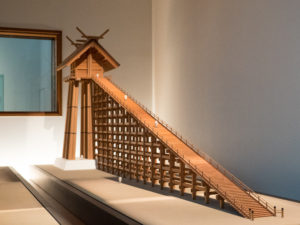
Model of an earlier version of Izumo Taisho Shrine in the Shimane Museum of Ancient Izumo (古代出雲歴史博物館).
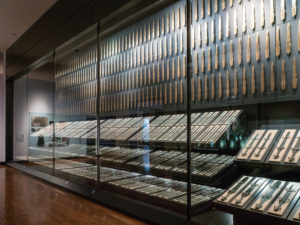
Display of ceremonial bronze swords found in archeological excavations near Izumo Taisho Shrine, displayed in Shimane Museum of Ancient Izumo.
After that we walked to the Izumo Taisha Shrine (出雲大社), the oldest Shinto shrine in Japan. Many preparations were being made for the New Years holiday. There were some visitors but I expect it was very busy during the week after we left. We admired the shimenawa (a straw rope that marks the boundary between the sacred and profane), the largest in the world. There are small charming statues of hares near the shrine (from the myth of the “Hare of Inaba”). We walked around the complex of shrines, then along the long path marked by paired lines of tall pine trees, and finally into the town of Izumo.
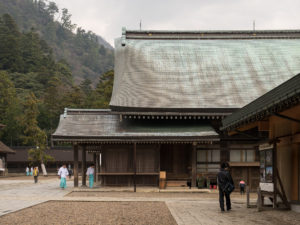
One of the beautiful buildings at the Izumo Taisho Shrine (出雲大社).
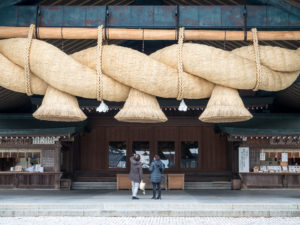
Admiring the shimenawa at Izumo Taisho Shrine, the oldest Shinto shrine in Japan.
Two young men introduced themselves while we were strolling down the street. They are young entrepreneurs working for Huber <https://huber-japan.com/?corporate>, a startup company that connects visitors (especially from overseas) with local guides. What a great concept! Huber put a video showing the sites of San’in (Shimane and Tottori prefectures) up on Youtube: <https://www.youtube.com/watch?v=H3pj_hVYsK8>. If I had known about this it would have saved me several weeks of research. I will use them for our next trip to Japan!
Matsue Castle is a well-preserved castle that is one of the 12 remaining original castles in Japan, and is in its original wooden form. We walked to the top of the castle and admired the view of the city and Lake Shinji. Later we went looking for dinner, walked towards the railway station and found a great restaurant called 炉端焼き こにこ <https://tabelog.com/shimane/A3201/A320101/32004267/> that had a menu in English. I had a wonderful set of sashimi (delicious!), miso soup and some sake. My wife had steamed rockfish cooked in an almost Chinese style. Ummm!
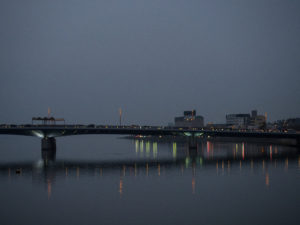
Lake Shinji (宍道湖) from a bridge in Matsue on a December evening.
Day three – Okuizumo
Our third day in Shimane was even more of an adventure. I had discovered a website <https://okuizumo.org/en/> that listed a museum on iron- and sword-making in Okuizumo, a town up in the hills south of Shinji, a town between Matsue and Izumo. Japan has a long history of pre-industrial history of iron and swords and the Okuizumo area is the center of it. I contacted them in well in advance and arranged for an English-speaking guide to take us there. On some weekends there are demonstrations of sword forging and sword cutting. Alas, we were not going there on a weekend.
We took a JR train from Tamatsukurionsen to Shinji first thing in the morning. Thick fog swirled in and out of the station, and for the first time in Japan our train was late. By the time we arrived in Shinji we missed our connection to the train that would take us up into the hills to Izumoyokota station. (Later we learned that the fog was so thick that many flights to and from the Izumo airport were cancelled.)
We started looking for a taxi to take us there so we would not be late meeting our guide. The stationmaster came out of the station and told us not to worry, that he had arranged a taxi to come in ten minutes. A taxi showed up ten minutes later and we, along with a businessman, got into the taxi as the stationmaster told us that the railway would pay for the taxi! We were completely stunned by his kindness and generosity. Everywhere we went in Japan we were met with kindness and patience, but this was amazing.
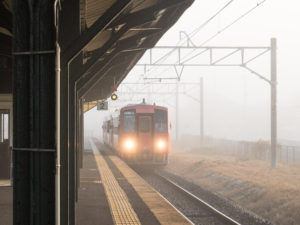
Waiting our train to Shinji as thick fog rolls into Tamatsukurionsen station (玉造温泉駅).
We soon arrived at Izumoyokota station, ten minutes or so before the train arrived where we met our guide, Sameera, from the Okuizumo Travel Guide. This organization was set up in the town of Okuizumo to encourage more visitors to come and stay. Sameera arranged for us to rent a taxi for three hours.
The first stop was the Okuzumi Tatara and Sword Hall (奥出雲たたらと刀剣館). Outside the museum is a statue of Yamata no Orochi, an eight-headed serpent that was slain by the god Susanoo, brother of Amaterasu, the powerful sun goddess. After slaying Yamata no Orochi, Susanoo removes a special sword called Kusanagi from the serpent’s tail. This legendary sword is used to enthrone a new emperor. There are some deep connections between Shinto and steel that I would like to know more about…
Once inside the museum, Sameera translated some of the signs for us. There were displays of the raw materials such as iron sand. Japan’s source of iron ore for many centuries is iron sand, basically, iron ore that has eroded from granite a long time ago and ended up as heavy sand particles.
There were so many people digging up the hills in this area that eventually the ruler limited the number of people who could make iron. Apparently, a third of the terraced rice fields in this area are land that has been reclaimed from this search for iron.
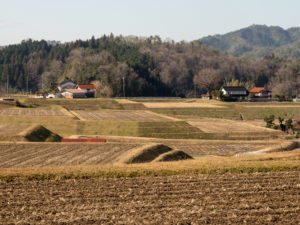
Terraced rice fields, renovated from land used in older quests for iron ore in the hills around Okuizumo.
The museum had exhibits on the iron-making process and, of course, the processes for making swords. They were wonderfully done but it’s challenging for someone who is suddenly illiterate (in Japanese) to fully appreciate. There was a full-scale model of a tatara furnace. Some of the exhibits were scale models of the processes in action, complete with models of people and the tools.
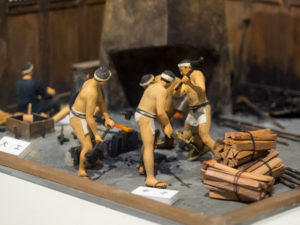
A scale model of workers forging steel in the Okuzumi Tatara and Sword Hall (奥出雲 たたらと刀剣館) in Okuizumo.
This traditional method of making iron came close to dying out when the western methods of making steel were implemented in Japan at the beginning of the 20th century. In recent times, the government has encouraged the renewal of these methods and the Okuizumo museum is one result of this.
Earlier in our trip, we had gone to Kagoshima, in southern Kyushu, to go see, among other things, the Shuseikan project which is part of the “Sites of Japan’s Meiji Industrial Revolution” World Heritage site. We saw the site of an early reverberatory furnace for making steel in the 1850s. This was Japan’s first source of steel produced by Western methods. We also saw museum-quality Satsuma cut glass, the Sengan-an garden and the Shimadzu family (Satsuma Clan) residence, all exquisitely beautiful. On another day we visited the Higashida Daiichi blast furnace site in Kitakyushu. It was fired up for the first time on Febrary 5, 1901 and shut down for the last time in 1972. So we saw three very different generations of steel technology in Okuiuzmo (1500s through early 1900s), Kagoshima (1850s and later) and Kitakyushu (1901 to 1972). Since I am interested in industrial archelogy and the history of technology this aspect of our trip was fulfilling.
We left the museum with Sameera and drove by some terraced rice fields on our way to a fantastic soba restaurant, Himeno Soba Yukarian (姫のそば ゆかり庵) <https://tabelog.com/shimane/A3202/A320203/32003128/>. When we came in we were the only people there, but by the time we left every table was full. They make excellent soba. I had cold soba and my wife had the hot soba. Both were outstanding and we purchased some of their soba to bring home.
We then went to the Itohara Memorial Museum (絲原記念館). The Itohara Family is one of three families which have lived in Okuizumo for nearly 400 years and controlled the iron business. Tesshi were the heads of the official ironworkers, who managed everything from collecting materials to the completion of steel production. The museum has three main exhibits: tatara iron making, arts and handcrafted items, and tea ceremony instruments. We walked through the museum and garden, and enjoyed some tea in the restaurant.
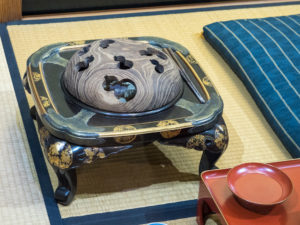
One of the treasures in the Itohara Memorial Museum (絲原記念館).
At the conclusion of our tour we were dropped off at the Izumo-Minari railway station which is also where the Okuizumo Travel group has their offices. Since it was December, all over Japan everyone was shopping for local and regional specialty foods for the new year. Almost every railway station had stores with the local delicacies, even in Izumo-Minari. The station also had a shop that sells local products such as sake, soba noodles, soy sauce, and other local products. We bought some soy sauce made by Morita Shoyu, one of the oldest soy sauce makers in Okuiuzmo and one of the very few makers who makes soy sources using organic ingredients.
With some purchases in hand, we took the JR train to Shinji along the Kisuki Line (木次線) in a single-car train. This is a charming railroad line that goes through small towns, rice fields and valleys. Most of the other passengers were students heading home. I was taking some photos when the engineer indicated that I could stand in the front of the car, next to his compartment. As the train glided by farms, valleys, small towns, over bridges, in and out of tunnels I watched from the front window. It felt like being in a Miyazaki anime, a wonderful way to end the day.
So many people to thank!
Throughout our trip to Japan we were treated with warmth, kindness and patience. The whole trip was marvelous but our time in Shimane was the most moving. In part this is because of the people whom we met, including Mayumi, Todani, Sameera, Ishin, Koki and the many others who made our visit so memorable. When we return to Japan, no matter where else we go I expect we will come back to Japan to see our friends. Doumo sumimasen, arigatougozaimasu!
Any errors are mine alone for which I apologize in advance.


